29 Oct 2024
The Transformative Power of Blockchain Decentralized Finance: Unlocking New Opportunities
Matthew Connor
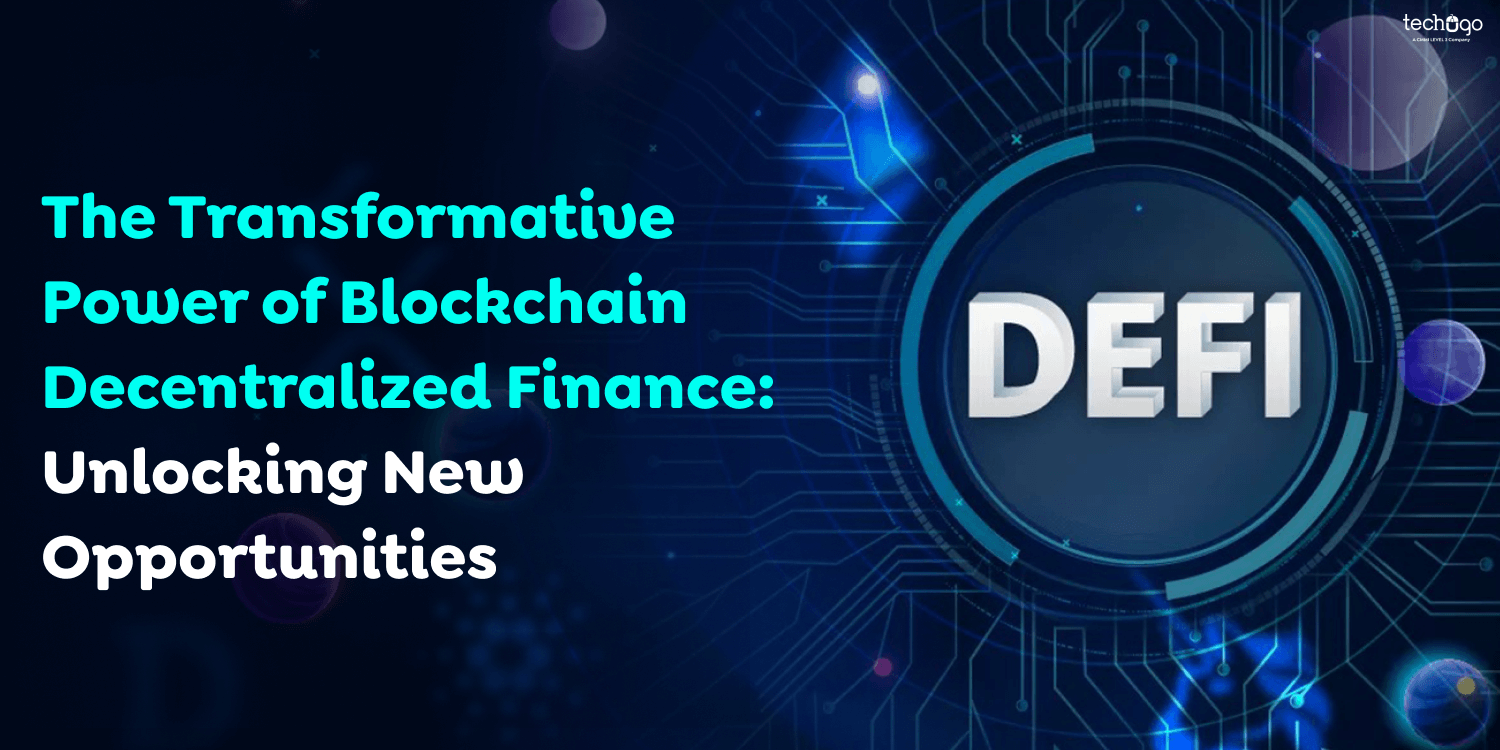
Trust has always been the foundation of finance. Depositors trust banks to keep their funds, insurance policyholders can trust insurance companies to cover claims, and lenders trust the borrower to reimburse trading partners to honor deals. In the past, trust was best achieved via intermediary banks subject to significant government supervision.
Blockchain technology and cryptocurrencies have contributed to a new model that guarantees trust by removing the use of algorithmic protocols and other algorithms by banks and government agencies. This system of decentralized financial services, also known as DeFi, is the next phase of finance.
Blockchain decentralized finance (DeFi) has quickly grown from a small part of the market for cryptocurrency to becoming a major player in the banking and finance world. By 2024, the amount secured for DeFi-related protocols will surpass $60 billion. That is substantial growth from just one billion dollars in the past. Numerous technological advances and innovations are driving the increase in this area, fundamentally changing how financial services are provided and used.
Understanding DeFi
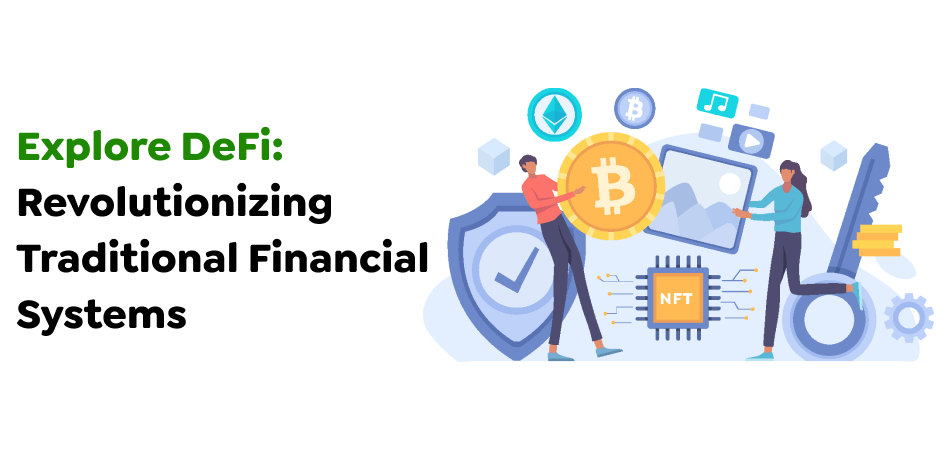
DeFi stands for Blockchain-based financial services that are decentralized instead of “centralized” financial services provided via banks or other conventional financial institutions. The cryptocurrency platform allows users to offer the majority of services traditional banks provide using official fiat currencies—lend, loan to earn interest, trade products, make insurance purchases, and more. The DeFi service is generally quicker, more affordable, and easier to use as it is constantly upgraded with new daily benefits and services.
DeFi uses smart contracts which do not rely on traditional financial institutions as intermediaries in transaction verification; participants in its decentralized finance ecosystem instead transact directly among each other with transactions secured using blockchain technology. Most DeFi devices don’t have custody of your money, allowing you to control your financial assets. With DeFi, it is possible to access your accounts or funds using a secure digital wallet. If you wish to transact with DeFi, you can do so using smart contracts. That means both parties accept a set of particular terms.
In this case, a smart contract may be made to send money to an account daily, which will continue when funds are sufficient. When a smart contract is established, it cannot be modified, meaning money can’t be routed to an alternative account. Most DeFi-related applications are built upon the Ethereum blockchain, but other platforms are also rapidly developing similar apps. DeFi is at its beginnings compared to centralized financial systems, and it releases new applications every day.
Also Read : Revolutionizing Investment: How to Build a Trading App Like Robinhood
Core Technologies Powering DeFi
The popularity of cryptocurrency is also growing across emerging economies, as Bitcoin is embraced as a hedge against currency devaluation. As an instrument for integrating people who are not banked.
The other significant aspect of the framework is smart contracts. These are self-executing agreements where the contract’s terms are written in codes. Blockchain decentralized finance knowledge is insufficient without an understanding of smart contracts. As the name implies, smart contracts are automated contracts that do away with the need for transaction intermediaries.
Smart contracts stored on blockchains use algorithms that enforce a set of guidelines that each user of the blockchain must authorize. Smart contracts guarantee that the blockchain program will only work when specified conditions are met. These contracts will eliminate intermediaries, allow for trust-free transactions, and automate intricate financial operations.
Also Read : Key Strategies to Build a Successful Mobile App for Startups
Defi vs. Traditional Banks
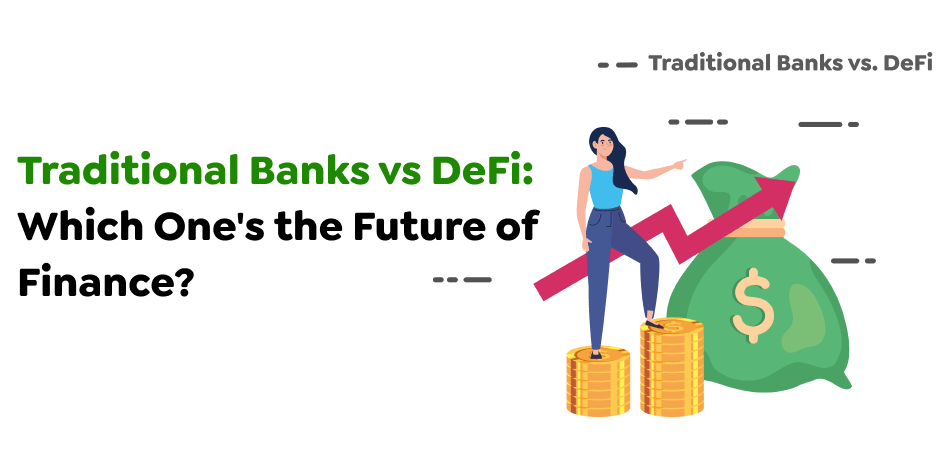
Traditional banks and DeFi don’t have to be exclusive to each other. They can coexist and respond to customers’ different requirements. Traditional banks provide a comfortable and secure setting for your everyday financial transactions.
DeFi, on the other hand, offers a peek into the future of financial services with greater control, flexibility, and the potential for innovative ideas. Your decision is ultimately based on your conditions, risk tolerance, and economic objectives.
As a blockchain app development company we will clear the fundamental difference between traditional banks and DeFi.
Centralization vs. Decentralization
The main difference is in the control. A centralized system governs traditional banks, meaning one entity controls your money, determines transaction fees, and sets lending rates.DeFi, on the contrary side, is in favor of decentralization. In this case, the power lies with the end users and is facilitated through blockchain technology.
The transactions are recorded on an open ledger accessible to everyone who participates, and a vote of the community makes decisions. This is the primary reason behind the widespread popularity of DeFi, the development tool.
1. Accessibility And Inclusion
Traditional banks typically have strict conditions for opening accounts and obtaining financial services. These can be barriers for those with limited credit records or who reside in non-banked areas. DeFi, thanks to its non-permissionless nature, allows for greater access.
2. Transparency And Speed
Traditional banks may be transparent in their business practices, but they have complex fees and slow processing times for transactions, particularly international transfers. DeFi provides a more transparent service.
The transactions are stored on a publicly accessible blockchain, allowing users to track their fees and assets in real-time. Furthermore, DeFi transactions can be substantially faster and less expensive than traditional bank transfers.
3. Innovation And Flexibility
Traditional banks usually move slower when embracing new technology or financial products. DeFi, however, is an incredible hotspot for new ideas.
4. Security And Regulation
Traditional banks are tightly controlled and usually have robust security procedures to safeguard user money. DeFi, a brand-new system, is prone to dangers. Security vulnerabilities in smart contracts and hacks may result in possible fund losses. The regulations regarding DeFi remain in flux, and some consumers are cautious about potential dangers.
Major DeFi Use-Cases
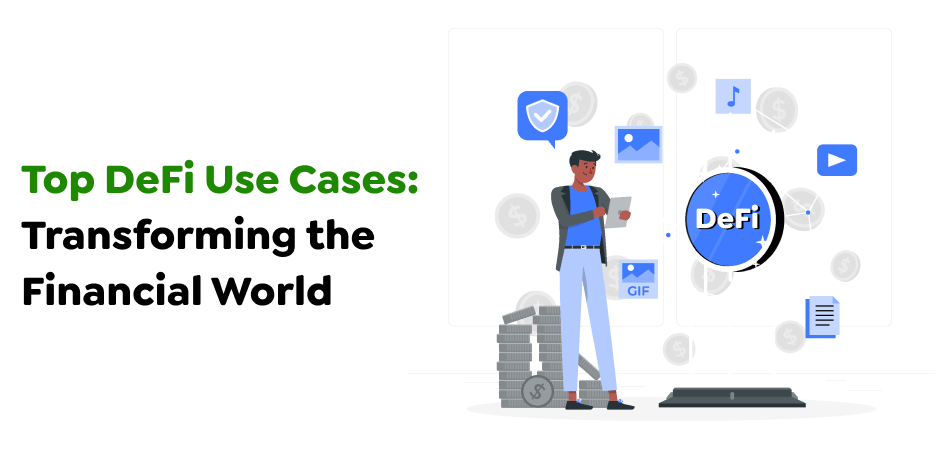
Here are some of the best use cases of DeFi:
1. Lending And Borrowing
The most widely used usage cases for the DeFi ecosystem are peer-to-peer loans and borrowing. DeFi lets users borrow funds without the need to fill in an application or even have an account with a bank.The borrower does not need to find a lender through the DeFi application; instead, the smart contract acts as the lender, calculating interest rates by analyzing demand and supply.
Loans have a predetermined interest rate for different blockchain decentralized finance applications. Blockchain decentralized finance can make the lending and borrowing process much more straightforward and quicker.
2. Stablecoins
A different important application for DeFi is stablecoins. Cryptocurrencies are made to provide a stable price compared to fiat currencies. Stablecoins are crucial to DeFi apps because they are the stability of a unit of account and also a currency suitable for making investments and transactions.
3. Insurance
Smart contracts contain the terms and conditions encoded digitally as codes. Once the conditions are set, the insurance company can compensate the insured person without facing any difficulties.
4. Metaverse
Top companies are creating specific Metaverses to communicate with their customers and increase sales effectively. Additionally, to ensure smooth online space, leading Metaverse companies are working to integrate aspects of DeFi to deliver improved buying experiences for their clients. Using decentralized finance, firms can ensure quick, transparent, and secure transactions because there aren’t banks or intermediaries that are not third-party.
5. Synthetic Assets
Cryptocurrency-backed synthetic assets offer investment exposure to various assets like gold, fiat, and digital currencies, secured by tokens linked to Ethereum-based smart contracts with embedded incentives and contractual agreements.Blockchain decentralized finance promises to integrate various smart contracts simply.
6. Yield Farming
Yield farming involves having users offer liquidity to DeFi protocols to earn rewards. There are many ways of performing this, but the most common is putting cryptocurrency assets into a liquidity pool. If a user deposits their digital assets in the liquidity pool, it provides the needed liquidity and allows the smooth trading of tokens through uncentralized exchanges. As a reward, the users get a fee for trading in rewards.
7. Decentralized Exchanges (DEXs)
Decentralized exchanges, or DEXs, play a significant role in DeFi by allowing customers to trade cryptocurrency confidently, ensuring safe and transparent decentralization. DEXs utilize smart contracts to enable trades, eliminating the need for intermediaries, such as central exchanges. Therefore, DEXs have many advantages over traditional exchanges. These include greater security, privacy, and control over assets.
8. Tokenization
Tokens are digital currency that the blockchain system makes, issues, and controls to ensure secure and immediate transfer. Tokenization is an integral feature of the Ethereum blockchain and the fundamental element of decentralized finance. Tokens provide the basis of the blockchain and allow for various potential economic opportunities. They also offer digital solutions for people to use to trade, exchange, and store their worth worldwide.
9. Analytics & Risk Management
Transparency and decentralization opened the way for users of all kinds to access and analyze an enormous amount of information. They can also discover opportunities in finance and implement the most effective risk-management methods.
The development of this technology has led to innovative data analytics that incorporate the use of blockchain-based tools, dashboards, and other platforms, as well as DeFi initiatives such as DeFi Pulse or CoDeFi Data. Businesses, financial institutions, and fintech app development company are astonished by the number of benefits of analytical tools and risk management instruments. Since companies have become more flexible, they are the most significant DeFi usage case factors.
10. Liquidity Provision
Liquidity service is described as a middleman trading into and out of small-scale holdings on a frequent periodic basis. The liquidity providers typically issue their requests to market participants at prices that reflect the knowledge available regarding asset prices and the possibility of trading or keeping the asset.
The liquidity providers stand out due to their ability to provide liquid liquidity throughout the day, not only in the event of a need to build or liquidate longer-term asset portfolios. With the current market, liquidity providers should be diversified to facilitate risk transfer and efficiently connect buyers and sellers during trading.
11. Digital Identification
Digital identity systems based on blockchain have gained much popularity in recent months. When combined with DeFi protocols, they facilitate access to global economic systems significantly more simply.
Digital identity, financial activities, and skills for professionals are essential in DeFi. A digitally enhanced identity could enable users to access information anytime and anywhere connected to the internet. This is just one of the possibilities for DeFi’s applications.
12. Infrastructure Tooling
Composability is an attribute of the DeFi ecosystem, which acts as an infrastructure-based protocol to connect and interact with system components. Infrastructure tools are essential for DeFi applications because DeFi projects are connected through networks.
13. Savings
In light of the soaring rate of inflation as well as the low interest rates for fiat currencies, it is often hard to save money; that’s why those who fear risk across the globe are constantly looking for better strategies to invest and save.
14. Asset Management
DeFi assists users in managing their investments more effectively. Through DeFi, clients can access strategies for asset management built on intelligent contracts created to maximize returns and minimize their exposure to volatility and various other market risks. Furthermore, DeFi enables users to control their assets throughout the day. This eliminates the possibility of mismanaging or losing holdings compared to conventional services for managing investments.
15. Payment Solutions
Since its beginning, the need to serve the underbanked and unbanked has motivated DeFi. Today, DeFi’s unique attributes make it ideal for solving the issues with our international payment systems. Compared to conventional payment methods, DeFi provides faster, safer, and more accessible alternatives.
DeFi-based blockchain payment systems could appeal to the unbanked population. Since they remove the requirement for intermediaries to make payments more straightforward and accessible.
Leading DeFi Trends To Watch In 2024
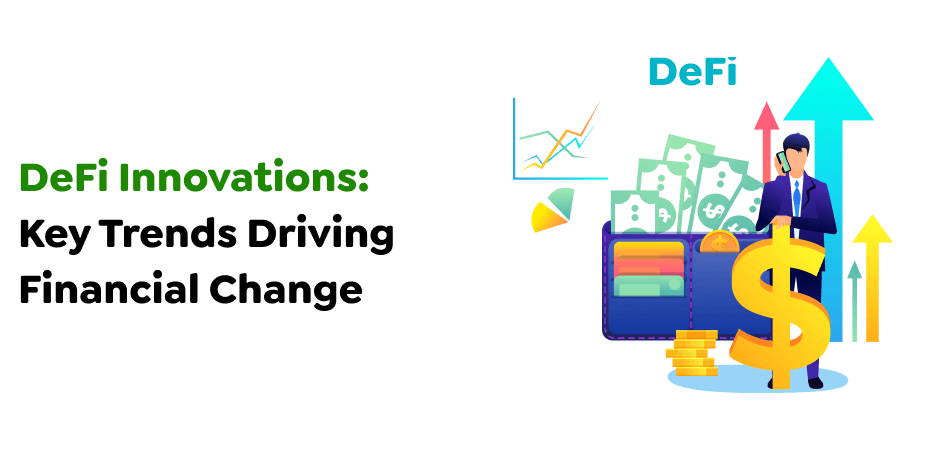
Let’s explore the most cutting-edge financial trends decentralizing in 2024—trends that empower companies to enhance their strategies and achieve unprecedented profits.
1. Traditional Finance Integration
Integration of DeFi in traditional financial systems is a rapid change within the world of finance. It is becoming more popular when conventional financial institutions begin incorporating DeFi protocol protocols using tokenization, smart contracts, and features for decentralized lending. This is a step toward universal access to financial services with increased efficacy and accessibility.
2. Layer 2 Scaling Solutions
Layer 2 scaling options emerge as a major technological breakthrough in DeFi and will likely have a significant role to play through 2024. These technologies facilitate faster and cheaper transactions and ensure the safety of the blockchain used to create them. The ability of Layer 2 solutions to enhance the efficiency of blockchain systems is vital to the ongoing advancement of DeFi technology.
Layer 2 is a type of network or system that developers build over the blockchain protocol to increase capacity and efficacy. The scaling solution is offloading part of a blockchain’s transactions to a different system, which handles most of the process and reports on the blockchain’s main one for the final step. This means the blockchain layer used as the basis becomes smaller and ultimately more flexible by transferring most information processing functions to the supplementary system infrastructure.
3. DEX And AMM Innovations
Decentralized Exchanges (DEXes) and Automated Market Makers (AMMs) are pivotal in transforming the financial market. They offer users unparalleled freedom, security, and access to a variety of financial assets. The growing significance of DEXes and AMMs is in their ability to adapt and innovate.
They tackle the inherent weaknesses while taking advantage of the strengths of traditional and decentralized financial systems. In transitioning from the AMM model to the traditional structure of order books, they aim to improve liquidity, increase trading effectiveness, and satisfy the needs of a wider range of users. The transition will enhance the democratization of financial services by encouraging greater adoption of DeFi platforms and promoting an inclusive and effective worldwide financial system.
4. Crypto Bridges
These bridges have been deemed essential for Web 3.0. Their rise has enabled seamless asset transfer to Layer 2 networks Crypto bridges’ effectiveness, flexibility, and enhanced user experience allowing an enhanced trading platform for ERC-20 tokens while maintaining Ethereum accessibility.
The incorporation of crypto bridges in the DeFi protocol has simplified the exchange of tokens across various platforms and eliminated the need for users to use a variety of interfaces. The effectiveness, flexibility, and enhanced user experience of crypto bridges are significant factors in their growing demand.
5. Real-World Assets
Real-world Asset (RWA) tokenization transforms tangible assets into digital tokens or NFTs and allows their trading through blockchain networks. The process opens up investor opportunities and links the traditional and digital worlds. RWAs can provide reliable yields and appeal to investors looking for diversification in stable income streams. They also encourage international market participation by eliminating geographical limitations and cutting down on barriers to entry.
6. Intents Based Architecture
The current situation of DeFi is time-consuming and complex, requiring users to search and conduct transactions across various platforms and networks. Typically, transactions describe “how” an action should be performed. However, intention-based systems specify “what” the desired outcome of an action is.
Users can select the desired result in intent-based systems without describing every transaction parameter. This contrasts starkly with traditional transaction models, which demand that users specify every aspect of their transactions explicitly.
Also Read : Transform Financial Services with Custom Loan Lending App Development
Launch Of Decentralized Physical Infrastructure Networks (DePIN)
Decentralized Physical Infrastructure Networks provide a groundbreaking strategy that utilizes blockchain technology to build, control, and manage physical infrastructure in a distributed manner. The blockchain decentralized finance industry is witnessing a significant trend in 2024. DePIN could change physical infrastructure with the integration of blockchain technology.
DePINs allow for real-time, autonomous interactions in physical infrastructures, using technology like smart contracts and the Internet of Things (IoT). This improves the system’s responsiveness and ability to respond to changing needs and is an important step in infrastructure management.
What’s Next For Decentralized Finance Technology?
Innovations in DeFi happen quickly, and there’s no reason to expect this to slow down anytime soon. Various trends could determine the direction of DeFi technology over the next few years. Machine learning and artificial intelligence could impact DeFi by transforming risk assessment methods and decision-making. They could streamline trading strategies and assess creditworthiness more effectively.
Artificial intelligence-driven instruments can predict market trends more accurately than previously thought possible.Second, is the emergence of DAOs and their ability to redefine how decentralized finance can govern. By allowing for voting with token holders on crucial issues like an upgrade of protocol or allocating funds, DAOs offer decentralized decisions.
As software, fintech and app development company get more advanced and grow, they have a significant role in developing DeFi. The final area of regulation will likely have a substantial influence on DeFi’s direction. The world’s governments are fast becoming aware of the need for oversight of the rapidly growing industry. Although regulation may be complex, it does have the potential to benefit DeFi by enhancing visibility and consumer protections on the path to widespread use.
Conclusion
DeFi offers numerous opportunities for a secure and reliable financial system without a central authority. This new financial system empowers the users’ community to govern, removing the inefficiencies of the conventional financial system. The technology used to achieve this goal is the key to understanding how it will make finance more accessible.
A basic grasp of the underlying technology is essential to benefit from the financial crisis. DeFi technology is constantly evolving, with advancements in security, scalability, and interoperability. When these technologies mature and become more advanced, they can open opportunities for decentralized finance to create a more diverse and forward-looking financial system. At Techugo, a mobile app development company, we are at the forefront of building cutting-edge DeFi applications to help you harness the full potential of blockchain decentralized finance and revolutionize your financial landscape.
Get in touch with us to explore how blockchain decentralized finance can revolutionize your financial strategy and unlock new opportunities!
Get In touch
We are excited to here from you and let’s start something special Together. Call Us for any inquiry.
Write us
sales@techugo.caJust a call away
About you




